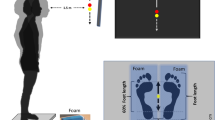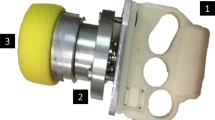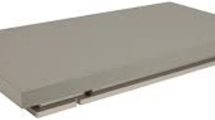Abstract
Maintenance of postural control is a complex task that requires the integration of different sensory-motor processes. To improve postural control, balance training is often implemented using unstable surfaces. Little is known, however, about how different surfaces compare in terms of postural control strategy. Non-linear dynamical system analysis, like recurrent quantification analysis (RQA) applied to the center of pressure (CoP) trajectory, represents a useful tool in this respect. The aim of this study is to investigate the effects of different unstable supports on the CoP trajectory through a complementary approach based on linear and non-linear analyses. Seventeen healthy adults performed barefoot single-leg balance trials on a force plate and on three different balance training devices (soft disc, foam pad, and pillow). Sets of parameters were extracted from the CoP trajectories using classical stabilometric analysis (sway path, mean velocity, root mean square) and RQA (percent recurrence and determinism, maximum line length, entropy). Both classical and RQA analyses highlighted significant differences between stable (force plate) and unstable conditions (p < 0.001). Conversely, only classical stabilometric parameters showed significant differences among the considered balance training devices, indicating that the different characteristics of the devices do not influence the dynamic/temporal structure of the CoP trajectory.
Graphical abstract
Analysis of the center of pressure trajectory during single-leg standing on three different balance training devices and on a rigid surface using both linear and non-linear techniques.





Similar content being viewed by others
Abbreviations
- AP:
-
Anteroposterior
- CoP:
-
Center of pressure
- ED:
-
Embedding dimension
- Ent:
-
Entropy
- EVA:
-
Ethylene vinyl acetate
- MaxLine:
-
Maximum line length
- ML:
-
Mediolateral
- MV:
-
Mean velocity
- RMS:
-
Root mean square
- RQA:
-
Recurrent quantification analysis
- SP:
-
Sway path
- %Det:
-
Percent determinism
- %Rec:
-
Percent recurrence
References
Forbes PA, Chen A, Blouin JS (2018) Sensorimotor control of standing balance. Handb Clin Neurol 159:61–83. https://doi.org/10.1016/B978-0-444-63916-5.00004-5
Peterka RJ (2002) Sensorimotor integration in human postural control. J Neurophysiol 88:1097–1118. https://doi.org/10.1152/jn.2002.88.3.1097
Roncesvalles MNC, Woollacott MH, Jensen JL (2001) Development of lower extremity kinetics for balance control in infants and young children. J Mot Behav 33:180–192. https://doi.org/10.1080/00222890109603149
Mickle KJ, Munro BJ, Steele JR (2011) Gender and age affect balance performance in primary school-aged children. J Sci Med Sport 14:243–248. https://doi.org/10.1016/j.jsams.2010.11.002
Piirtola M, Era P (2006) Force platform measurements as predictors of falls among older people - a review. Gerontol 52:1–16. https://doi.org/10.1159/000089820
Hübscher M, Zech A, Pfeifer K et al (2010) Neuromuscular training for sports injury prevention: a systematic review. Med Sci Sports Exerc 42:413–421. https://doi.org/10.1249/MSS.0b013e3181b88d37
Zech A, Hübscher M, Vogt L et al (2009) Neuromuscular training for rehabilitation of sports injuries: a systematic review. Med Sci Sports Exerc 41:1831–1841. https://doi.org/10.1249/MSS.0b013e3181a3cf0d
Wong RMY, Chong KC, Law SW et al (2020) The effectiveness of exercises on fall and fracture prevention amongst community elderlies: a systematic review and meta-analysis. J Orthop Transl 24:58–65. https://doi.org/10.1016/j.jot.2020.05.007
Zech A, Hübscher M, Vogt L et al (2010) Balance training for neuromuscular control and performance enhancement: a systematic review. J Athl Train 45:392–403. https://doi.org/10.4085/1062-6050-45.4.392
Onigbinde AT, Awotidebe T, Awosika H (2009) Effect of 6 weeks wobble board exercises on static and dynamic balance of stroke survivors. Technol Heal Care 17:387–392. https://doi.org/10.3233/THC-2009-0559
Ogaya S, Ikezoe T, Soda N, Ichihashi N (2011) Effects of balance training using wobble boards in the elderly. J Strength Cond Res 25:2616–2622. https://doi.org/10.1519/JSC.0b013e31820019cf
Kidgell D, Horvath D, Jackson B, Seymour P (2007) Effect of six weeks of dura disc and mini-trampoline balance training on postural sway in athletes with functional ankle instability. J Strength Cond Res 21:466–469
Boccolini G, Brazzit A, Bonfanti L, Alberti G (2013) Using balance training to improve the performance of youth basketball players. Sport Sci Health 9:37–42. https://doi.org/10.1007/s11332-013-0143-z
de Brito Silva P, Oliveira AS, Mrachacz-Kersting N et al (2016) Strategies for equilibrium maintenance during single leg standing on a wobble board. Gait Posture 44:149–154. https://doi.org/10.1016/j.gaitpost.2015.12.005
Bryanton MA, Bilodeau M (2019) The effect of vision and surface compliance on balance in untrained and strength athletes. J Mot Behav 51:75–82. https://doi.org/10.1080/00222895.2017.1423019
Haworth JL, Strang AJ, Hieronymus M, Walsh MS (2018) Temporal more than spatial regulation of sway is important for posture in response to an ultra-compliant surface. Somatosens Mot Res 35:45–51. https://doi.org/10.1080/08990220.2018.1445988
Cimadoro G, Paizis C, Alberti G, Babault N (2013) Effects of different unstable supports on EMG activity and balance. Neurosci Lett 548:228–232. https://doi.org/10.1016/j.neulet.2013.05.025
de Brito Silva P, Mrachacz-Kersting N, Oliveira AS, Kersting UG (2018) Effect of wobble board training on movement strategies to maintain equilibrium on unstable surfaces. Hum Mov Sci 58:231–238. https://doi.org/10.1016/j.humov.2018.02.006
Pai YC, Patton J (1997) Center of mass velocity-position predictions for balance control. J Biomech 30:347–354. https://doi.org/10.1016/S0021-9290(96)00165-0
Simoneau M, Corbeil P (2005) The effect of time to peak ankle torque on balance stability boundary: experimental validation of a biomechanical model. Exp Brain Res 165:217–228. https://doi.org/10.1007/s00221-005-2290-1
Scoppa F, Capra R, Gallamini M, Shiffer R (2013) Clinical stabilometry standardization. Basic definitions - acquisition interval - sampling frequency. Gait Posture 37:290–292. https://doi.org/10.1016/j.gaitpost.2012.07.009
Lemay J, Gagnon D, Nadeau S et al (2014) Center-of-pressure total trajectory length is a complementary measure to maximum excursion to better differentiate multidirectional standing limits of stability between individuals with incomplete spinal cord injury and able-bodied individuals. J Neuro Eng Rehabil 11:1–11
Prieto TE, Myklebust JB, Hoffmann RG et al (1996) Measures of postural steadiness: differences between healthy young and elderly adults. IEEE Trans Biomed Eng 43:956–966. https://doi.org/10.1109/10.532130
Riley MA, Balasubramaniam R, Turvey MT (1999) Recurrence quantification analysis of postural fluctuations. Gait Posture 9:65–78. https://doi.org/10.1016/S0966-6362(98)00044-7
Ramdani S, Tallon G, Bernard PL, Blain H (2013) Recurrence quantification analysis of human postural fluctuations in older fallers and non-fallers. Ann Biomed Eng 41:1713–1725. https://doi.org/10.1007/s10439-013-0790-x
Cavanaugh JT, Guskiewicz KM, Stergiou N (2005) A nonlinear dynamic approach for evaluating postural control: new directions for the management of sport-related cerebral concussion. Sport Med 35:935–950. https://doi.org/10.2165/00007256-200535110-00002
N Stergiou UH Buzzi MJ Kurz J Heidel (2004) Nonlinear tools in human movement. In: Stergiou N (ed) Innovative analyses of human movement, Human Kine. pp 63–90
Duarte M, Zatsiorsky VM (2000) On the fractal properties of natural human standing. Neurosci Lett 283:173–176. https://doi.org/10.1016/S0304-3940(00)00960-5
Bottaro A, Casadio M, Morasso PG, Sanguineti V (2005) Body sway during quiet standing: is it the residual chattering of an intermittent stabilization process? Hum Mov Sci 24:588–615. https://doi.org/10.1016/j.humov.2005.07.006
Mazaheri M, Negahban H, Salavati M et al (2010) Reliability of recurrence quantification analysis measures of the center of pressure during standing in individuals with musculoskeletal disorders. Med Eng Phys 32:808–812. https://doi.org/10.1016/j.medengphy.2010.04.019
Eckmann JP, Oliffson Kamphorst O, Ruelle D (1987) Recurrence plots of dynamical systems Epl 4:973–977. https://doi.org/10.1209/0295-5075/4/9/004
Webber CL, Zbilut JP (1994) Dynamical assessment of physiological systems and states using recurrence plot strategies. J Appl Physiol 76:965–973. https://doi.org/10.1152/jappl.1994.76.2.965
Apthorp D, Nagle F, Palmisano S (2014) Chaos in balance: non-linear measures of postural control predict individual variations in visual illusions of motion. PLoS ONE 9:e113897. https://doi.org/10.1371/journal.pone.0113897
Balasubramaniam R, Riley MA, Turvey MT (2000) Specificity of postural sway to the demands of a precision task. Gait Posture 11:12–24
Ghomashchi H, Esteki A, Nasrabadi AM et al (2011) Dynamic patterns of postural fluctuations during quiet standing: a recurrence quantification approach. Int J Bifurc Chaos 21:1163–1172. https://doi.org/10.1142/S021812741102891X
Negahban SN, Ravikumar P, Wainwright MJ, Yu B (2012) A unified framework for high-dimensional analysis of m-estimators with decomposable regularizers. Stat Sci 27:538–557. https://doi.org/10.1214/12-STS400
G Pellecchia K Shockley (2005) Application of recurrence quantification analysis: influence of cognitive activity on postural fluctuations. In: Riley MA, Van Orden GC (eds) Tutorials in contemporary nonlinear methods for the behavioral sciences. pp 95–141
Riley MA, Clark S (2003) Recurrence analysis of human postural sway during the sensory organization test. Neurosci Lett 342:45–48. https://doi.org/10.1016/S0304-3940(03)00229-5
Schmit JM, Regis DI, Riley MA (2005) Dynamic patterns of postural sway in ballet dancers and track athletes. Exp Brain Res 163:370–378. https://doi.org/10.1007/s00221-004-2185-6
Sylos Labini F, Meli A, Ivanenko YP, Tufarelli D (2012) Recurrence quantification analysis of gait in normal and hypovestibular subjects. Gait Posture 35:48–55. https://doi.org/10.1016/j.gaitpost.2011.08.004
Stergiou N, Decker LM (2011) Human movement variability, nonlinear dynamics, and pathology: is there a connection? Hum Mov Sci 30:869–888. https://doi.org/10.1016/j.humov.2011.06.002
van den Hoorn W, Hodges PW, van Dieën JH, Kerr GK (2020) Reliability of recurrence quantification analysis of postural sway data A comparison of two methods to determine recurrence thresholds. J Biomech 107:109793. https://doi.org/10.1016/j.jbiomech.2020.109793
Cohen J (1992) Statistical power analysis. Curr Dir Psychol Sci 1:98–101. https://doi.org/10.1111/1467-8721.ep10768783
Lee D, Kim H, An H et al (2018) Comparison of postural sway depending on balance pad type. J Phys Ther Sci 30:252–257. https://doi.org/10.1589/jpts.30.252
Mezzarane RA, Kohn AF (2007) Control of upright stance over inclined surfaces. Exp Brain Res 180:377–388. https://doi.org/10.1007/s00221-007-0865-8
Bizovska L, Janura M, Svoboda Z et al (2017) Intra- and inter-session reliability of traditional and entropy-based variables describing stance on a wobble board. Med Eng Phys 50:29–34. https://doi.org/10.1016/j.medengphy.2017.08.017
Baltich J, von Tscharner V, Zandiyeh P, Nigg BM (2014) Quantification and reliability of center of pressure movement during balance tasks of varying difficulty. Gait Posture 40:327–332. https://doi.org/10.1016/j.gaitpost.2014.04.208
Wälchli M, Ruffieux J, Mouthon A et al (2018) Is young age a limiting factor when training balance? Effects of child-oriented balance training in children and adolescents. Pediatr Exerc Sci 30:178–186. https://doi.org/10.1123/pes.2017-0061
Verbecque E, da Costa PHL, Meyns P et al (2016) Age-related changes in postural sway in preschoolers. Gait Posture 44:116–122. https://doi.org/10.1016/j.gaitpost.2015.11.016
Chiari L, Rocchi L, Cappello A (2002) Stabilometric parameters are affected by anthropometry and foot placement. Clin Biomech 17:666–677. https://doi.org/10.1016/S0268-0033(02)00107-9
Kantz H, Schreiber T (2003) Phase space methods. In: Kantz H, Schreiber T (eds) Nonlinear time series analysis, 2nd edn. Cambridge University Press, Cambridge, UK, pp 30–47
Peng H, Long F, Ding C (2005) Feature selection based on mutual information: criteria of max-dependency, max-relevance, and min-redundancy. IEEE Trans Pattern Anal Mach Intell 27:1226–1238. https://doi.org/10.1109/TPAMI.2005.159
Kennel M, Brown R, Abarbanel H (1992) Determining embedding dimension for phase-space reconstruction using a geometrical construction. Phys Rev A 45:3403–3411. https://doi.org/10.2307/2554626
CL Webber JP Zbilut (2005) Recurrence quantification analysis of nonlinear dynamical systems. In: Riley MA, Van Orden GC (eds) Tutorials in contemporary nonlinear methods for the behavioral sciences. pp 26–94
Aickin M, Gensler H (1996) Adjusting for multiple testing when reporting research results: the Bonferroni vs Holm methods. Am J Public Health 86:726–728. https://doi.org/10.2105/AJPH.86.5.726
Riley MA, Baker AA, Schmit JM, Weaver E (2005) Effects of visual and auditory short-term memory tasks on the spatiotemporal dynamics and variability of postural sway. J Mot Behav 37:311–324. https://doi.org/10.3200/JMBR.37.4.311-324
Ivanenko YP, Levik YS, Talis VL, Gurfinkel VS (1997) Human equilibrium on unstable support: the importance of feet-support interaction. Neurosci Lett 235:109–112. https://doi.org/10.1016/S0304-3940(97)00721-0
Abrahamová D, Hlavacka F (2008) Age-related changes of human balance during quiet stance. Physiol Res 57:957–964
Shumway-Cook A, Horak FB (1986) Assessing the influence of sensory interaction on balance. Suggestion from the field Phys Ther 66:1548–1550. https://doi.org/10.1093/ptj/66.10.1548
Acknowledgements
The authors would like to thank all the volunteers who kindly participated in the data acquisition. This research did not receive any specific grant from funding agencies in the public, commercial, or not-for-profit sectors.
Author information
Authors and Affiliations
Contributions
John McCamley: conceptualization, methodology, software, formal analysis, writing — original draft, writing — review and editing.
Elena Bergamini: conceptualization, methodology, formal analysis, writing — original draft, writing — review and editing, visualization, supervision
Eleni Grimpampi: conceptualization, methodology, software, formal analysis, investigation, resources, data curation, writing — review and editing, project administration, supervision
Corresponding author
Ethics declarations
Conflict of interest
The authors declare no competing interests.
Additional information
Publisher's note
Springer Nature remains neutral with regard to jurisdictional claims in published maps and institutional affiliations.
Rights and permissions
About this article
Cite this article
McCamley, J., Bergamini, E. & Grimpampi, E. Balance on different unstable supports: a complementary approach based on linear and non-linear analyses. Med Biol Eng Comput 60, 863–873 (2022). https://doi.org/10.1007/s11517-022-02504-4
Received:
Accepted:
Published:
Issue Date:
DOI: https://doi.org/10.1007/s11517-022-02504-4




